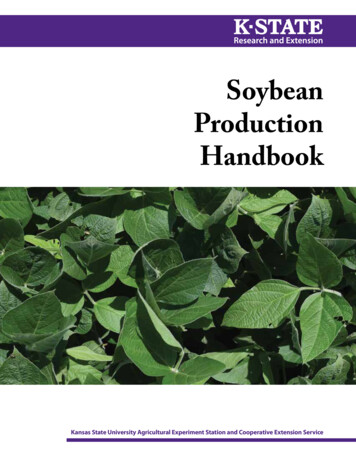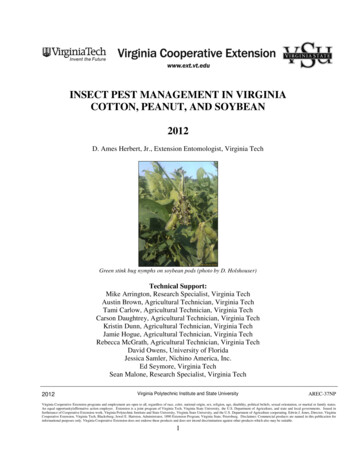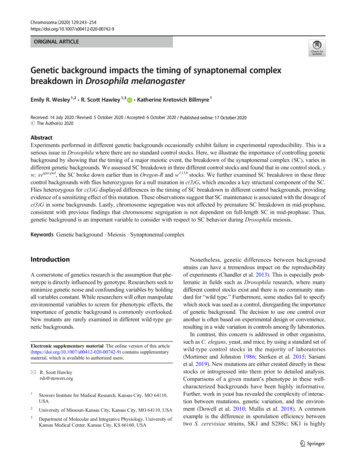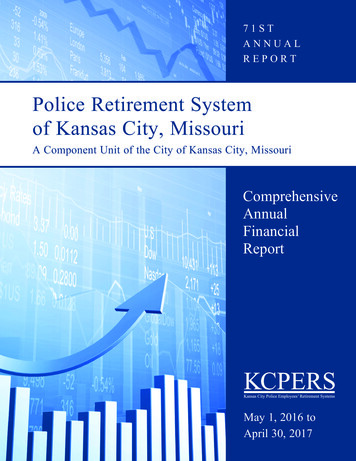
Transcription
SoybeanProductionHandbookKansas State University Agricultural Experiment Station and Cooperative Extension Service
ContentsGrowth and Development.1Ignacio A. Ciampitti, Crop Production and Cropping Systems SpecialistVariety Selection.7William T. Schapaugh, Soybean BreederSeedbed Preparation and Planting Practices.11Doug Shoup, Southeast Area AgronomistStu Duncan, Northeast Area AgronomistIgnacio A. Ciampitti, Crop Production and Cropping Systems SpecialistFertilization.14Dorivar Ruiz Diaz, Soil Fertility and Nutrient Management SpecialistWeed Management.16Dallas Peterson, Weed Management SpecialistIrrigation.19Danny H. Rogers, Irrigation EngineerSoybean Insects.24Jeff Whitworth, EntomologistHolly Schwarting, Entomology Research AssociateSoybean Diseases.28Doug Jardine, Extension Plant PathologistDrying and Storage.33Joe Harner, Agricultural EngineerProfit Prospects.35Mykel Taylor, Agricultural EconomistDomestic and International Soybean Marketing.38Daniel M. O’Brien, Extension Agricultural EconomistJay O’Neil, Agricultural Economist, International Grains ProgramHarvesting Soybeans.45Ajay Sharda, Agricultural EngineerLucas Haag, Northwest Area Agronomist
Growth and DevelopmentSeed Coat or TestaMicropyleHilumRapheSeed swells as it imbibes waterUnifoliolate LeavesCotyledonsEpicotylHypocotylRadicleRoot MeristemFigure 1. The primary parts of a soybean seed.K-State Research and ExtensionEmbryonicAxisApical MeristemSoybeans are planted in soil with an adequatemoisture level and warm temperatures (mid-50 degreesFahrenheit or higher) to allow rapid germination andemergence. Rapid germination occurs when soil temperatures are above 65 degrees Fahrenheit.Planting dates have shifted in the last 34 years toearlier dates at a rate of 0.5 day per year (Figure 2). Thechange in planting date may be attributable to changes in:genetics (e.g., improved germination and cold toleranceof modern soybean varieties); environmental conditions(e.g., warmer temperatures in spring); and managementpractices (e.g., tillage system, rotation, fertility, inoculation, and machinery).Optimum planting depth is around 1 to 2 inches,depending on the soil temperature and moisture. Forearly planting dates, as placement depth increases, theemergence period is extended, primarily related to thesoil temperature. For late planting dates, soil moistureplays a critical role in determining the time untilemergence. Shallow planting (less then 1 inch) withoutadequate moisture is not recommended. Placing the seedinto moist soil is the best strategy when planting late(Figure 3).Soil conditions will affect the time taken to achievesuccessful germination and emergence. Soil compactionor crusting produces a delay in soybean emergence,slowing the plant’s emergence and/or the root’s proliferation in the soil. Flooded soils have lowered oxygen levels,an obstacle for seed respiration and growth.During germination, a soybean absorbs an equivalentof 50 percent of its seed weight. As the soil temperatureapproaches an optimum for growth, the first organ toemerge from the seed is the radicle or primary root. ThisDate at 50% Planting (after March 31)Yield formation for soybeans starts with the plantingof the seed in the ground and ends when the grain isharvested. Soybean yield potential depends not only onseed selection, but also on the soybean’s genetics and theenvironmental characteristics in which the plant wasgrown during development until harvest.Understanding how a soybean plant grows, develops,and produces grain is essential for understanding thefactors that affect plant growth (biomass accumulation)and maximize final yield production.Soybean seed and its composition is the first component discussed in this chapter. The seed (Figure 1) is aliving organism that remains dormant until conditionsfor germination are achieved. The most important seedcomponents are: testa (seed coat); cotyledons (firstleaves to emerge); hypocotyl (first stem of the plant aftergermination, this tissue is between the cotyledons andradicle); epicotyl (section of the small plant that presentsthe stem); unifoliate leaves (the two primary leaves); andthe apical meristem.July 10June 30June 20June 10May 30May 20May 101980June 10April 30Soybean:Slope -0.5 day per yearApril 20April 102014May 23March 31197519801985199019952000200520102015YearFigure 2. Planting date 50 percent (after March 31) forKansas. Historical planting 50 percent date evolutionfrom 1980 to 2014 (USDA, Kansas Crop Progress andCondition).1
organ quickly develops into the primary seedling root.The elongation of the hypocotyl (stem) follows thisprocess, which pulls the cotyledons (seed leaves) abovethe ground. The hook-shaped hypocotyl straightens outsoon after emergence. This type of emergence is knownas “epigeal,” refering to the position of the cotyledonafter the seedling emerges. Planting depth influences thelength of the hypocotyl (elongation), producing a pooroverall emergence as the planting depth increases. Thisaffects the time required from planting until emergence.Emergence can vary from 5 to 21 days depending on soiltemperature and moisture.Stages of GrowthFigure 3. Effect of soil temperature during early season(04/22 planting date) established soybean crop (upper photo)and during late season (lower photo) (06/17 planting date)as compared to diverse seed planting depth (shallow 1-inch, adequate 2-inch). Photos by Ignacio A. Ciampitti,K-State Research and Extension.Figure 4. Early growth and development for soybean,germination and emergence process (upper photo) and earlyvegetative stages (lower photo). Photos by Kevin Donnelly,Kansas State University.2It is important to understand how soybeans grow anddevelop. Since their vegetative and reproductive growthstages occur for several weeks, many environmentalconditions can affect final yield. Too much or too littlemoisture at specific stages of growth can affect performance. Even the type of soybeans, i.e. determinate orindeterminate, influences when a plant starts the flowering or pod-filling stage.When determining the soybean growth stages,consider that your soybean field will be in a specificgrowth stage only when 50 percent or more of the plantsare in the stage evaluated.Soybean Production Handbook
Vegetative StagesCotyledon (VC)Unifoliolate leaves expand (leaf edges are nottouching). The cotyledons are the main nutrient reservoir for the young soybean plants (7 to 10 days old).Damaged cotyledons can lower yields.Management Practices: Scout for proper emergence.Weed control is important before and after soybeansemerge. If stand is poor, replanting may be needed.Growing pointVn growthstages N e eVegetative StagesEmergence (VE)During germination and emergence, the cotyledonpokes through the soil and primary and lateral rootgrowth begins. Functional root hairs develop shortly afterplanting. Root hairs are essential to nutrient uptake andwater absorption when the plant is at this early stage.Management Practices: Scout for proper emergence;check final stand and uniformity. Optimum seed placement varies from 1 to 2 inches deep. Deeper plantingdepth (greater than 2 inches) and lower soil temperaturesjeopardize final emergence. If the stand is poor, replantingmay be needed.VCFirst trifoliolate (V1)Trifoliolate leaf unrolls (fully developed leaves at theunifoliolate nodes). The plant becomes self-sustaining asnewly developed leaves carry out photosynthesis. Fromthis point onward, new nodes will appear every 3 to 5days until V5 stage (five-node stage), and then every 2 to3 days until the last vegetative node.Management Practices: Scout for early-seasonweeds, insects, and diseases.CotyledonsLeaf edges not touchingHypocotylFully developed unifoliolateleafVENode 1Node 0V1K-State Research and Extension3
Second trifoliolate (V2)Two trifoliolates unroll (fully developed trifoliateleaves at nodes above the unifoliate node.). Check forproper inoculation. Nodulation has been established onthe roots at this stage and nitrogen fixation continuesuntil late reproductive stages. Effective nodulation resultsin higher yields and more protein when compared with anon-nodulated soybean plant.Management Practices: Scout for early-season weeds,insects and diseases. Apply postemergence herbicides ifneeded. If nodulation has been established effectively,nitrogen fertilization is not recommended, and, if appliedin large quantities, it will inhibit nitrogen fixation activity.TerminalbudStages V3 through V6The third trifoliolate (V3) stage takes place whenthree trifoliolates are unrolled. In case of damage tothe growing point, axillary buds permit the plants tocompensate yield or final productivity.The unrolling of six trifoliolates indicates the V6stage. The root system continues to grow, even expandingacross 30-inch row spacing.The V growth stages continue as long as the plantcontinues to produce trifoliolates. Determinate soybeanplants complete most of their vegetative growth whenflowering begins. Indeterminate plants produced trifoliolates until the beginning of seed formation stage (latereproductive period).TrifoliolateleafLeaf edgesnot touchingPetioleUppermost nodecounted, node 2Lowest nodecounted, node 1Unifoliolate budsAuxiliary budsCotyledonarynodesV2Reproductive StagesR1R1BeginningFlowering4R3R2Full BloomR5R4R3Beginning PodR4Full PodR5Beginning SeedR6R6Full SeedR7R7BeginningMaturityR8R8Full MaturitySoybean Production Handbook
Reproductive StagesBeginning flowering (R1)Plant has one flower open at any node on the mainstem. Indeterminate plants start flowering at the bottomand flower upward. Determinate plants start flowering atone of the top four nodes and flower downward.Management Practices: Scout for insects anddiseases. Spray foliar insecticide or fungicide, if needed.Beginning pod (R3)Pods are 3/16 inch (5 mm) long in one of the fouruppermost nodes on main stem with a fully developed leaf.Management Practices: Scout for insects anddiseases. Spray foliar insecticide or fungicide, if needed.Identify water stress, which affects pod formation. If it isa common practice, irrigation is critical at this stage. Lateseason hail damage to the leaf area at this stage severelyaffects final yields.5mm podR3FlowerR1Full bloom (R2)Soybean plant has one open flower on one of the twouppermost nodes on the main stem with a fully developed leaf.Management Practices: Scout for insects anddiseases. Spray foliar insecticide or fungicide, if needed.Full pod (R4)Pods are ¾ inch (2 cm) long in one of the fouruppermost nodes on main stem with a fully developedleaf. Almost 50 percent of nitrogen uptake occursaround this stage. When determining yield, stage R4marks the beginning of the most crucial period of plantdevelopment.Management Practices: Scout for insects and diseases.Late-season diseases can lower yields. Irrigation is also critical at this stage. Peak water use can reach 2.5 to 3 inchesper week. Spray foliar insecticide or fungicide, if needed.Uppermostnode countedFlowerUppermostnode countedR2K-State Research and cm podR45
Beginning seed (R5)Seed is 1/8 inch long (3 mm) in one of the fouruppermost nodes on the main stem. Primary and lateralroots grow strong until R5. After R5, the shallower rootsdegenerate, but the deeper roots and laterals grow untilR6.5.Management Practices: Scout for insects anddiseases. Late-season diseases can severely lower yields.Spray foliar insecticide or fungicide, if needed.Beginning maturity (R7)One pod on the main stem has reached mature podcolor.Management Practices: Scout for green stemsyndrome and other issues before harvest.Uppermostnode countedIndeterminatevarietyPodcavityR53mmseedsFull seed (R6)Pods contain a green seed that fills the pod cavity inone of the four uppermost nodes on main stem. Mostnutrients have been taken up by the time the plantreaches R6 stage.Management Practices: Scout for insects anddiseases. Late-season diseases can severely affect yields.Spray foliar insecticide or fungicide, if needed. Lateseason hail damage to the leaf area could lower yields.Uppermost nodecountedR7Full maturity (R8)Approximately 5 to 10 days before harvest, podsshould reach full maturity, where 95 percent of pods havereached mature pod color.Management Practices: Scout for green stemsyndrome. If the plant is still green, the best option is toharvest slowly and make sure the harvesting equipmentis sharp and inexcellent operatingcondition.Growth anddevelopment stagesinformation adaptedfrom Soybean Growthand Development,K-State Research andExtension, UnitedSoybean Board, andKansas SoybeanCommission 2015.Indeterminate varietyMature seedsGreen seedfilling thepod cavityR66R8Soybean Production Handbook
Variety SelectionThe choice of variety is a key factor in profitablesoybean production. Many characteristics, such as yield,yield stability, maturity, lodging, and disease resistancemust be considered when selecting varieties to complement a production area.Yield and Yield StabilityHarvestable yield is an important characteristicto consider when selecting a soybean variety. It is notunusual for one variety to outyield another variety by 5 to15 bushels in the same environment. Although improvements in yield do not occur at a rapid pace, a recentevaluation of genetic improvement of soybean varietiesin Kansas showed the development of improved varietiesrepresented an increase in yield of about one-third of abushel per acre per year.To make the best possible decision regarding yieldpotential, gather as much variety performance information as possible. Since the performance of any varietyvaries from year to year and from location to locationdepending on factors such as weather, management practices, and variety adaptation, consider the performanceof a variety across several locations for multiple years. Anaverage across years and locations provides a better estimate of genetic potential and stability than a single siteor only a few test sites. However, the selection process iscomplicated by the many new soybean varieties enteringthe market each year, while others leave the market. Forvarieties new to the market, where information acrossyears is limited or unavailable, evaluating performanceacross locations is especially important.MaturityMaturity must be closely matched to the productionenvironment and the cropping system. Maturity stronglyinfluences how plant development complements or isaffected by weather conditions. Figure 5 provides anoverview of the developmental periods of varieties withdiffering maturities planted in Kansas.While environmental factors such as heat affect physiological development, soybean plants also are sensitive today length or photoperiod. Because of this sensitivity, thetiming of the transition from vegetative to reproductiveor floral development stages and the rate of physiologicaldevelopment are primarily influenced by the photoperiod or day length requirements. Varieties differ in theirresponses to day length. Some varieties flower underrelatively short days (longer nights) while others flowerunder longer days (shorter nights). Varieties have beenclassified for photoperiod response based on the abilityof the variety to effectively use the length of the growingseason in a region.During the summer, daylight hours increase fromthe southern to northern United States. This changein photoperiod results in regions of adaptation in theform of horizontal bands running east to west across theUnited States from the northern states to the Gulf Coastarea. Each band extends 100 to 150 miles north to south(Figure gSeedFormationFigure 5. Soybean variety vegetative, flowering, and reproductive growth patterns.K-State Research and ExtensionFigure 6. U.S. Soybean maturity group map. Ten maturitygroups are depicted in this map from 00 to VIII. The higherthe number, the later the maturity and the further souththe variety is adapted for full-season use. Lines portrayed inthe map are for guiding purposes; there are no clearcut areaswhere a variety is or is not adapted.7
Varieties adapted for full-season production in aparticular region are assigned a maturity group number.Varieties in group 00 are adapted to the northernmostregions of North Dakota and Minnesota; those in groupVIII are adapted to the southernmost region of Floridaand the Gulf Coast states. As the maturity group numberincreases, the length of the vegetative and reproductivestages of development are extended. A spread of about 10days in maturity exists for varieties classified in the samematurity group.Varieties are often moved north or south of theirprimary area of full-season adaptation to complementa production area. Because of the change in day length,when a variety is moved to the north, flowering will bedelayed; when it is moved to the south, flowering will behastened.Varieties adapted to Kansas generally are classifiedin maturity groups III, IV, and V. Varieties from groupII tend to mature too early, even in a double-croppingsystem, except when grown in extreme northern orwestern Kansas. Group III varieties perform well innorthern Kansas and under irrigation throughout thestate. Early and mid-group IV varieties can be grownthroughout Kansas but perform best in the northeast, eastcentral, and central part of the state. Late IV and group Vvarieties perform best in southeast Kansas.Double-cropping is a common practice in Kansas. Asoybean crop following wheat is usually planted two tosix weeks later than a field under full-season production.Since planting is delayed, often until the end of June orearly July, a tendency exists to switch to a shorter seasonsoybean variety to ensure the crop matures before frost.While planting a later maturing variety increases thelikelihood of frost damage, resist switching to a substantially earlier maturing variety. Early maturing varietiesplanted late in the season usually have limited vegetativedevelopment, short stature, and low yield potential.Because of the photoperiod response, there are fewer daysto flowering, pod development, and maturity in laterplantings than earlier plantings of the same variety.When planting double-cropped soybeans, the daylength has begun or will soon begin to shorten. Thisreduction in the day length, or increase in the nightperiod, hastens plant development. Planting the samevariety at the end of June versus the end of May does notresult in a delay in maturity of one month. As a generalrule, for every three days delay in planting, maturity isdelayed by only one day. Since soybean development ishastened in later plantings, the highest yields in a doublecropped system are often achieved by a variety with thesame or only slightly shorter maturity than the varietyused in full-season production.8With environmental conditions fluctuating from yearto year, growers should consider planting varieties thatvary in maturity. Using a range of maturities can lowerthe risks associated with weather-related yield reductions,such as heat and drought stresses, and facilitates timelyharvest and efficient machinery use.Lodging ResistanceA variety must be able to remain erect throughoutthe growing season. Lodging during the vegetative orreproductive growth disrupts the light penetration intothe plant canopy and may reduce seed yield. Lodging latein the season may reduce harvest efficiency and increaseharvest losses.While varieties differ in their ability to resist lodging,environmental conditions greatly influence the tendencyto lodge. Factors such as irrigation and high fertilitypromote vegetative development and increase lodging.Increasing plant population causes the stems to becometaller, more slender, and more prone to lodging. Iflodging has been a problem in the past, consider selectinga more lodging-resistant variety in addition to re-evaluating the seeding rate at planting.Stem Termination TypeSoybean varieties are classified as indeterminate,determinate, or semi-determinate by their morphologicalgrowth habit or stem termination type. The indeterminate growth habit is typical of most maturity group IVand earlier soybean varieties grown in Kansas. Maturitygroup V and later varieties typically possess the determinate growth habit.Indeterminate varieties continue to grow vegetativelyseveral weeks after flowering, or floral initiation, begins.Plant height can more than double after floral initiation.In contrast, determinate varieties complete most of theirvegetative growth before flowering. Plant height canincrease slightly in determinate varieties after the onset offlowering, but generally 70 to 80 percent of the matureplant height is achieved before flowering.At maturity, the indeterminate plant tends to havea relatively even distribution of pods on the main stemwith a lower frequency toward the tip of the stem. Thedeterminate varieties tend to have a dense cluster of podson the terminal raceme at the top of the plant. Whencomparing varieties of similar maturity, indeterminatevarieties are usually taller than determinate ones. Thecharacteristics of a semi-determinate growth habit fallsomewhere between the extremes of the indeterminateand determinate types.While most of the varieties in group IV and earlierpossess an indeterminate growth habit, and varieties ingroups V and later possess the determinate growth habit,Soybean Production Handbook
exceptions to this rule do occur. A few group IV andearlier varieties have been released that are determinateor semi-determinate and a few group V or later maturityindeterminates have been released.The determinate growth habit in an early-maturitybackground results in short, compact plants that tend tohave excellent lodging resistance. These early-determinatevarieties (sometimes referred to as semi-dwarf varieties)are recommended for production systems involvingnarrow rows, high seeding rates, early plantings, goodfertility, and a yield potential in excess of 50 bushelsper acre. The determinate growth habit was originallyincorporated into varieties to reduce plant height andlodging in environments with long growing seasons. Theindeterminate growth habit, which has been incorporatedinto a few group V and later maturity backgrounds, tendsto result in a tall, bushy variety with a long floweringperiod. These late indeterminate varieties have beenrecommended for production in stress environments ordouble-cropped situations where vegetative productionmay be limited. Regardless of these general recommendations, it is important to select a variety based on itsperformance in the production area of interest.Disease ResistanceWidely varying environmental conditions exist inthe state during the growing season. These conditionsinfluence the occurrence and severity of diseases attackingsoybeans. Although numerous pathogens can affectsoybean production, soybean cyst nematode (SCN), charcoal rot, and soybean sudden death syndrome (SDS) arethree of the more damaging soybean diseases in Kansas.No single soybean variety provides complete protectionagainst these diseases; however, a number of controlmeasures involving variety selection help minimize lossesdue to these diseases.Populations of SCN are genetically diverse, varyingin their ability to reproduce on different plant speciesand on soybean varieties with different resistance genes.Resistant varieties work by limiting the reproduction ofSCN on roots, which may result in the reduction of thenematode population in the soil. Important facts to knowrelated to SCN resistance in soybean include: 1) mostvarieties derive their resistance from PI88788, 2) soybeanvarieties vary in the level of resistance they exhibit toSCN populations, and 3) most resistant varieties will notprevent the buildup of all populations of SCN.Based on an ongoing K-State Research and Extensionsurvey of SCN diversity, at least 25 percent of the fieldsin Kansas infested with SCN possess populations capableof sufficiently reproducing on PI88788 to maintainor increase population density. To properly managethis pathogen, it may be necessary to select a differentK-State Research and Extensionsoybean variety deriving its resistance from PI88788, orif available, a soybean variety deriving resistance from adifferent source. Unfortunately, the possibility exists thatno currently available soybean variety will adequatelyreduce the SCN population in a specific field and othermanagement practices will need to be implemented tocontrol the pathogen.Soybean sudden death syndrome has been increasingin Kansas, especially in fields with high yield potentialand those under irrigation. Although no varieties offercomplete resistance, varieties differ substantially in resistance or response to SDS. If a field has a history of SDS,seeking out the best source of resistance can producepositive results.Charcoal rot is an important disease associatedwith drought stress and high temperatures. Charcoalrot is one of the major soybean diseases without goodgenetic resistance. Currently, the best recommendationfor minimizing losses to charcoal rot is to select plantingdate, variety maturity, and cropping system and tillagecombinations that minimize drought and heat stressexperienced by the plants and produce the highest yield.Final yields are a good indication of the levels of droughtand heat experienced by the crop during critical periodsof development.Varieties with resistance to other destructive diseases,such as stem canker and Phytophthora root rot are available. Additional information on management strategiesto control these and other diseases can be found in thesoybean disease chapter.ShatteringEnvironmental conditions prevalent during harvestin Kansas often test a variety’s ability to resist shattering.The developer should have information on shatteringresistance from evaluating the shattering response of avariety when left in the field two weeks or longer aftermaturity or about one week or later after the optimumharvest time.Iron ChlorosisIn the central and western portions of the state, ironchlorosis is a common problem on highly calcareous soils.Although no soybean varieties are available with completeresistance to iron chlorosis, moderate levels of tolerancedo exist that allow for improved soybean production inmany problem areas. Often the developer knows howa particular variety responds to conditions favoring thedevelopment of iron deficiency chlorosis.TransgenicsThrough the use of genetic engineering, GMO varieties have been developed to carry special traits, such as9
resistance to certain herbicides or elevated levels of oleicacid — a mono-unsaturated fatty acid — in the seed.These varieties provide value to growers in addressingspecific weed problems or promising health advantages toconsumers. New GMO varieties are under developmentto continue improving production efficiency and end-usequality in soybeans, including new herbicide-resistance options. As these technologies become available,producers will need to evaluate if these varieties add valueto and merit integration into their production systems.Specialty UsesA majority of soybean acreage is devoted to production of soybean seed for the commodity or crushingmarket. However, soybean varieties are available thatdiffer in traits and grain characteristics necessary tomeet the standards for certain markets, including thosefor both food and feed. For example, elevated proteincontent or better protein digestibility may be desirablefor improved protein meal. Other markets may requireunique oil composition, such as those with high oleicacid, for increased functionality. Physical traits, such asseed size or texture, and visual traits, such as hilum color,may be suited for specific food uses. The introductionof GMO crops has resulted in demand for non-GMOand organic soybean for both commodity and specialtymarket applications.Production of soybean varieties capable of meetingthe need of specific uses provides the producer the opportunity to capture premiums for grain that possesses thesetraits. The opportunity for premiums must be weighedagainst the increased costs that might be associated withthe production of a variety that must be maintainedthrough identity-preserved channels, and the producermay need to have a contract to have a market outlet f
conditions can affect final yield. Too much or too little moisture at specific stages of growth can affect perfor-mance. Even the type of soybeans, i.e. determinate or indeterminate, influences when a plant starts the flow-ering or pod-filling stage. When determining the soybean growth stage










